Blog
Helical Piles (Piers) vs Concrete Foundations… Is there really a difference?
GoliathTech - 16 July 2024
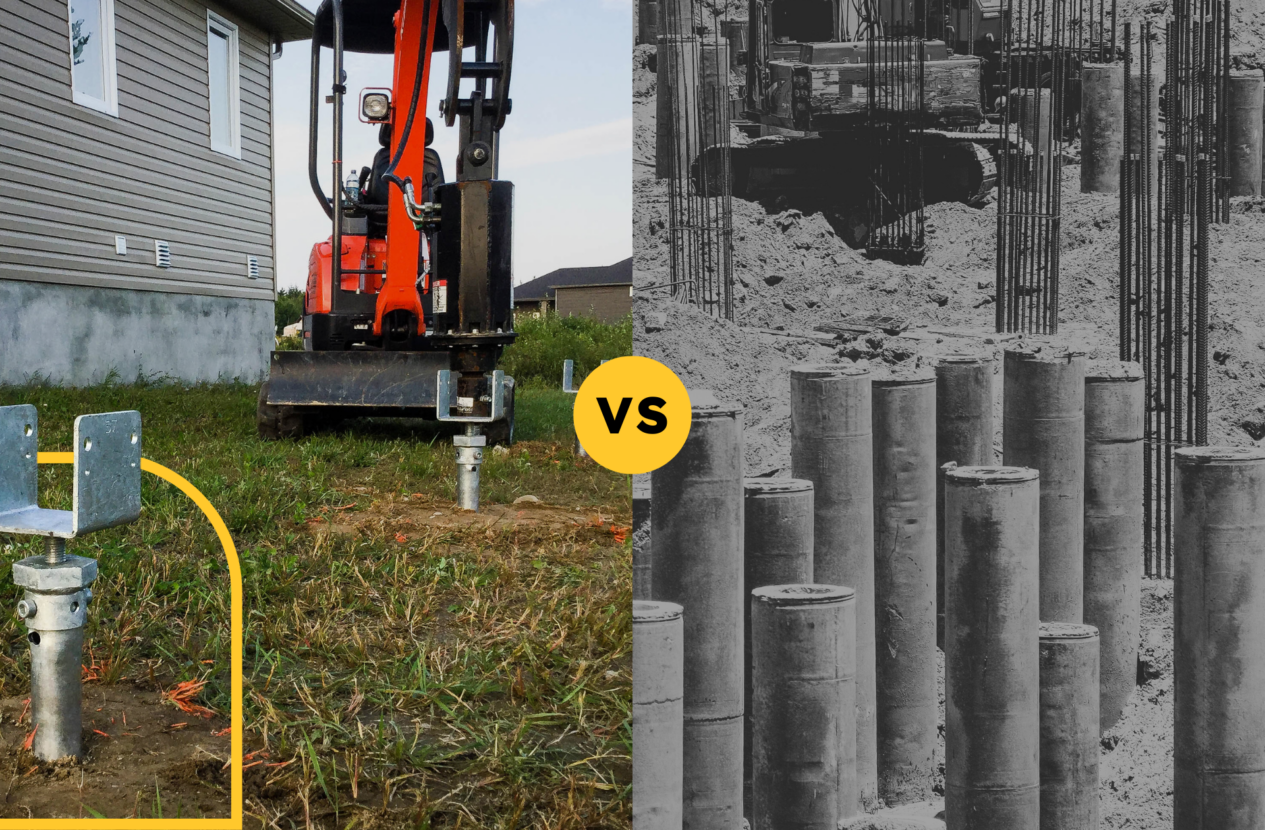
Since the foundation is one of the most crucial aspects of any construction project, it is essential to choose the right foundation system that can provide optimal support and stability to the structure.
Two of the most popular options for foundation systems are helical piles and concrete foundations. Each of these options has its advantages and disadvantages, and selecting the right one can make a significant difference in the project’s outcome.
We will explore the definition, advantages, applications, and costs of both foundation systems and answer the following question: does it really make a difference to choose one over the other?
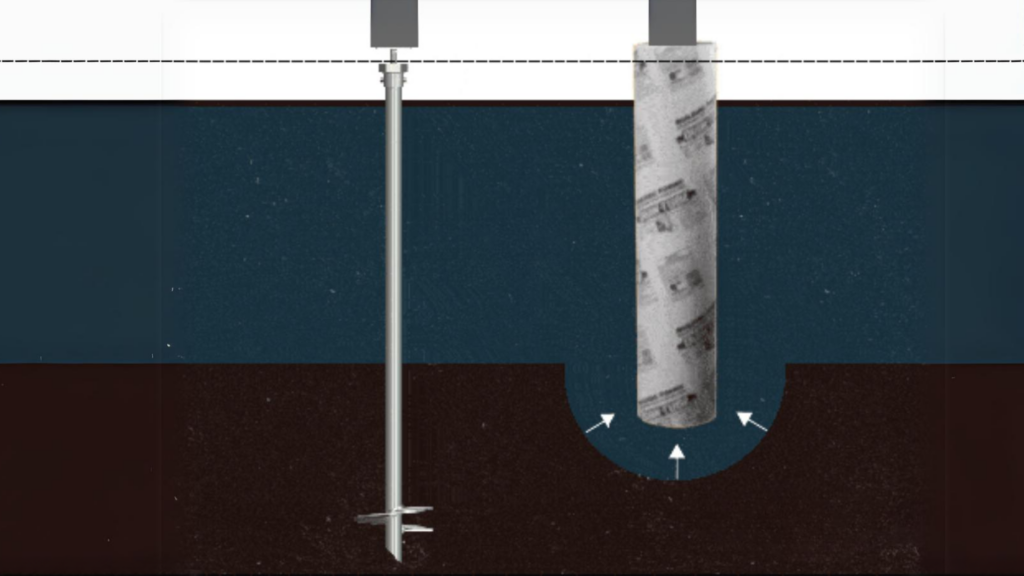
Definition and overview of Helical Piers (also known as Helical Piles or Screw Piles)
Helical piers (piles), are basically large screws that are installed in the ground below the frost line to provide support to a structure. By anchoring them into the ground, they provide a substantial grip and create a secure foundation.
Advantages of Helical Piles:
The advantages of having a helical pile foundation include the following:
- Can be installed in any weather conditions
- Provide immediate load-bearing capacity
- Cause minimal disruption to the surrounding landscape
- Can be installed in areas with limited access
- Require little to no excavation
- Can be easily removed and reused at another location
- Can be installed quickly, often within a few hours, reducing overall construction time
- Can be used in various soil types, including clay, sandy, and rocky soils
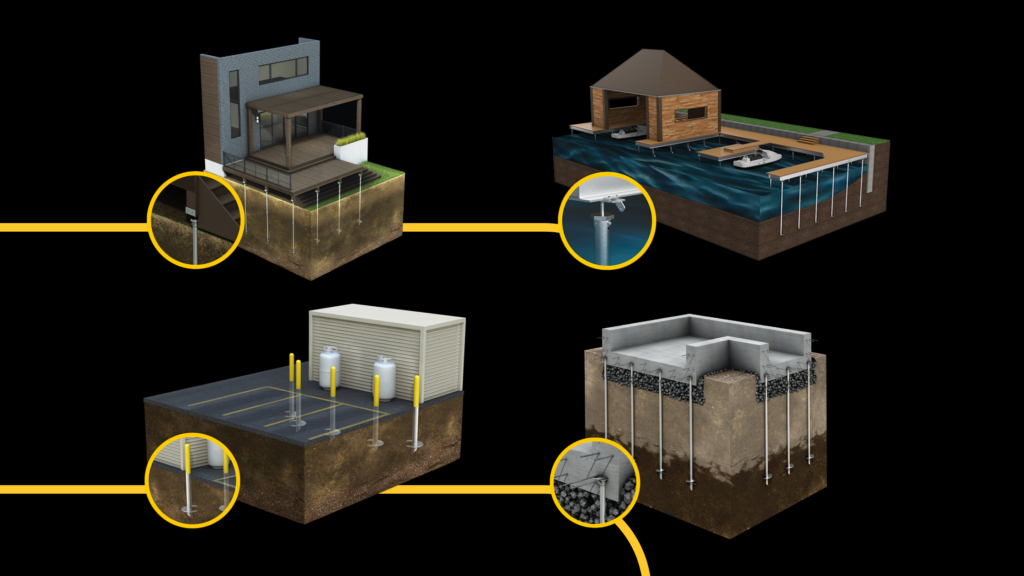
Applications of Helical Piers / Piles
Helical piles are utilized in a broad spectrum of construction projects, encompassing:
Examples of residential applications: decks, home and buildings, carports, cottage and cabins, balconies, exterior stairs, and much more.
Examples of commercial applications: agricultural tents, bridges and boardwalks, bollards and guardrails, electric charging stations, cell phone towers, and much more.
Examples of nautical applications: docks and boathouses
Examples of foundation repair: home foundations, retaining walls, and underpinning.
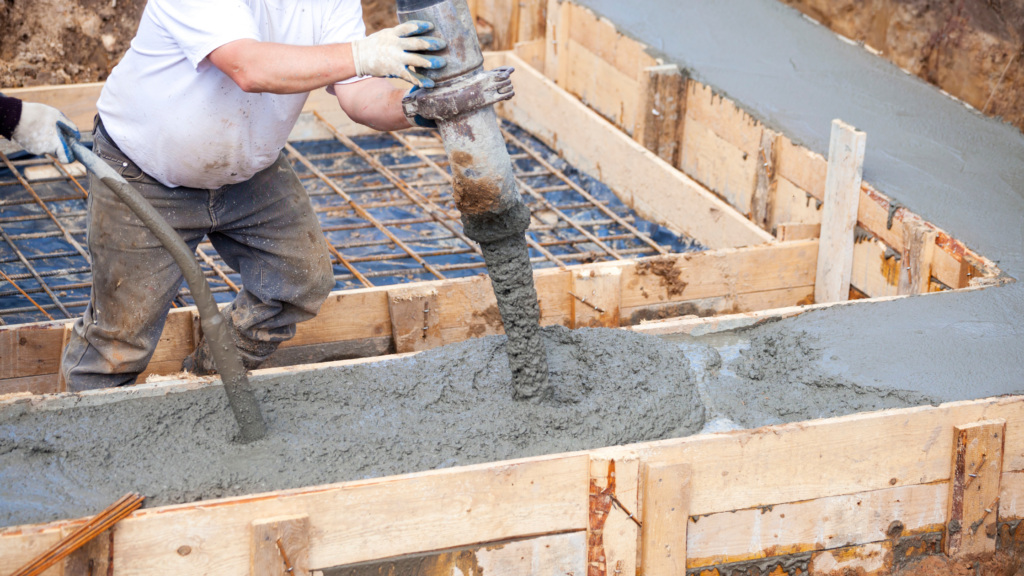
Definition and overview of concrete footing
Concrete footings are a traditional foundation system that involves digging a hole into the ground and pouring concrete into the hole to provide support to the structure. Concrete footings can vary in size and shape depending on the size and weight of the structure.
Characteristics of concrete footings
When a concrete basement is built for a house, an additional room is added to the residence. However, soil conditions must be taken into consideration to prevent the foundation from settling in the future. This is a good example of a situation where helical piles and concrete could be used together to solidify the foundation.
Applications of concrete footings
Concrete footings are commonly used in residential construction, such as:
- Decks
- Sheds
- Small garages
- Small additions
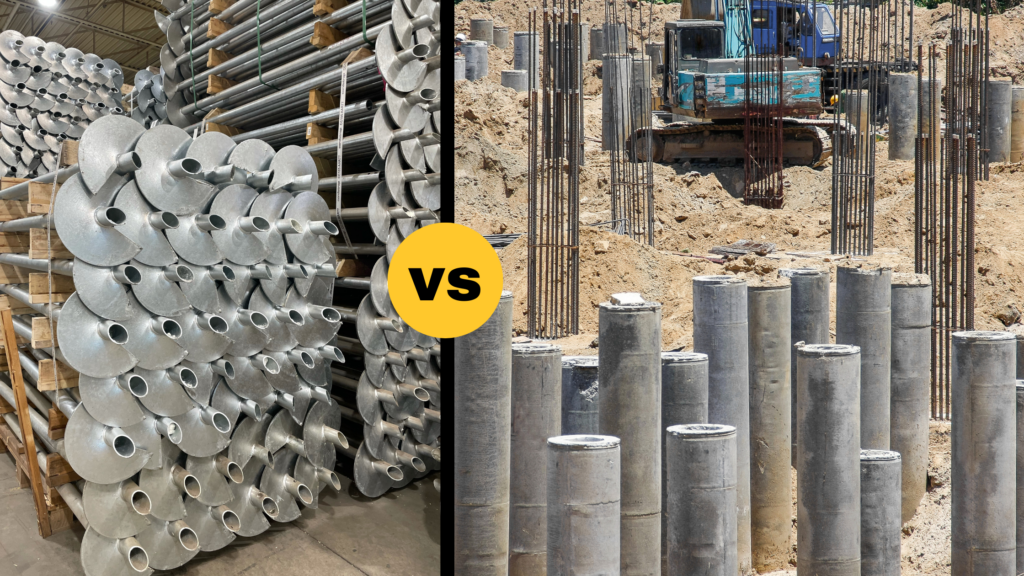
Comparing Helical Piers to concrete footings
Deciding between Helical Piers and concrete footings
Helical piles and concrete foundations each have their own advantages and disadvantages. The right foundation system for your project will depend on a variety of factors, including the size and weight of the structure, the type of soil, environmental conditions, accessibility, and budget.
Comparison of Helical Piers cost vs concrete footings
The cost of raw materials is generally lower with concrete than with helical piles. However, these initial savings come at the expense of stability and durability. Concrete foundations can be more prone to shifting, cracking, and settling over time, sometimes as soon as a year after installation.
While the initial cost of helical piles may be higher than concrete in terms of raw materials, the savings in labor costs, installation time, and excavation work more than offset this additional investment. To learn more, you can check out our blog post on the cost savings associated with choosing helical pile foundations.
Considering these factors is crucial for contractors looking to improve their team’s productivity. By doing so, they can take on more projects, reduce downtime, and provide superior foundations to their clients. Additionally, clients can complete their projects faster!
Choosing the right foundation system for a project is essential to ensure the stability, safety, and durability of the structure. A poorly designed foundation can lead to structural problems that can be costly to repair. Therefore, it is crucial to consult with experts and consider all factors when selecting a foundation system.
Combination of Helical Piles and concrete foundations for an optimal foundation
In some projects, combining helical piles and concrete foundations offers an ideal solution, merging the advantages of both systems for enhanced stability and durability.
Why combine Helical Piles and concrete?
Increased Stability: Helical piles enhance the stability of concrete, particularly in unstable soils. By driving deep into the ground, helical piles securely anchor the structure, reducing the risk of movement and settlement of the concrete.
Design Flexibility: This combination is adaptable to complex projects with varying or challenging soil conditions. Helical piles can be installed in a wide variety of soils, including clay, sandy, wet, and even rocky soils, offering flexibility that concrete alone cannot always provide.
Reduced Risk of Movement: By preventing the settlement and cracking of concrete, helical piles ensure a solid and immovable base for concrete foundations, thereby minimizing long-term maintenance and repair costs.
Quick Installation of Piles: Helical piles can be installed quickly, often within a few hours, allowing the site to be efficiently prepared before the concrete is poured. This speed reduces construction delays and the costs associated with equipment and crew mobilization.
Reduced Repair Costs: By minimizing the risks of cracks and settlements, the combination of helical piles and concrete reduces the frequency and extent of necessary repairs. Fewer cracks and settlements mean lower repair costs and greater longevity of the structure.
Durability: Concrete is known for its resistance to fire and wear, while helical piles offer stability and corrosion resistance when made from galvanized steel like GoliathTech Prestige helical piles. Together, they create a hybrid foundation that withstands the harshest climatic and environmental conditions.
Combining helical piles and concrete foundations offers a robust and long-lasting hybrid solution for construction projects. By maximizing the advantages of each material, this approach ensures a reliable and durable foundation capable of supporting the challenges of the most demanding soil conditions.
Final verdict on which is the better option - does it really make a difference?
There is no universal answer to the question of which foundation system is best. It essentially depends on the specific requirements and conditions of the project.
However, in general, helical piles offer several advantages over concrete foundations, such as increased productivity, enhanced foundation stability, improved load-bearing capacity, and greater durability.
For the majority of projects, helical piles are the ideal option due to their quick installation, adaptability to various soil types, and ability to prevent settlement and cracking issues. For projects requiring poured concrete, helical piles can reinforce the foundation by providing additional stability and avoiding costly long-term repairs. By combining helical piles with concrete foundations, a hybrid solution is achieved that maximizes the benefits of both systems, ensuring a solid and durable base for any type of construction.
In conclusion, while helical piles alone are often the best choice for many projects, their combined use with poured concrete for larger-scale projects enhances the foundation and prevents future problems. This makes it a preferred solution for projects requiring maximum reliability and longevity.
If you are interested in using helical piles for your project, please contact a certified GoliathTech installer. GoliathTech offers high-quality helical pile solutions for a wide range of applications, and our certified installers can help you choose the right foundation system for your project.
About GoliathTech
Since 2004, GoliathTech has been the most important manufacturer and installer in the helical (screw) pile industry worldwide. Our patented helical pile foundation system surpasses industry standards and has earned us multiple awards and prizes.
Carried out by certified installers, our quick installation process avoids excavation, which protects your landscape and allows you to begin building as soon as the piles are in the ground. Moreover, you can anchor GoliathTech’s helical pile foundations into any soil or space year-round. Installed deep into the ground, beneath the frost line, they solidly support the structure in even the most extreme conditions. Our technology guarantees that a helical (screw) pile foundation won’t move or crack over time.
Integrating both strength and know-how, GoliathTech offers the best anchoring solution to support your residential, industrial, commercial, and municipal projects. Trust the experience and expertise of GoliathTech for your foundation projects. Find a certified GoliathTech installer in your region or become a franchisee.
Other articles that might interest you
21 November 2024
What Are Foundation Screws? Benefits and Applications in Modern Construction
17 October 2024
How Long Do Concrete Footings Take to Dry? Is There a Faster Option?
25 September 2024

